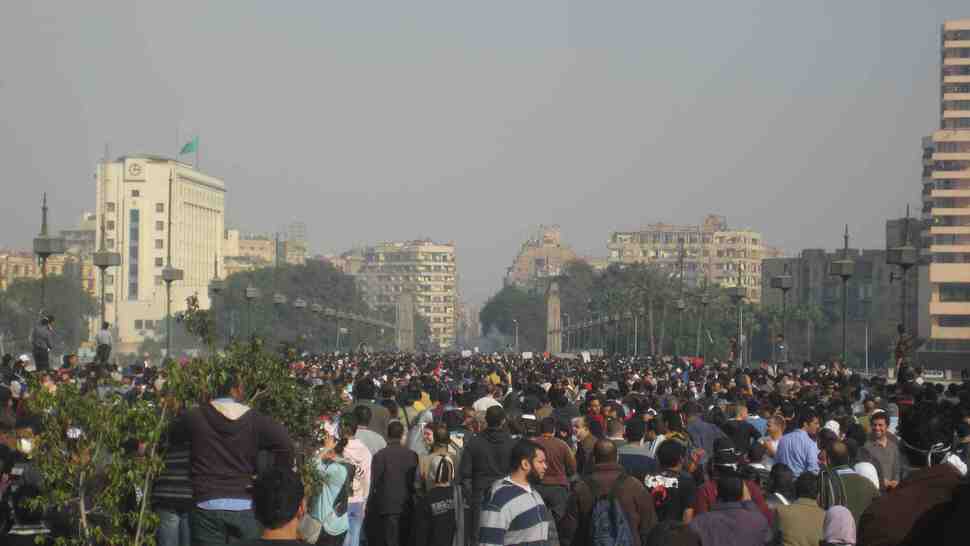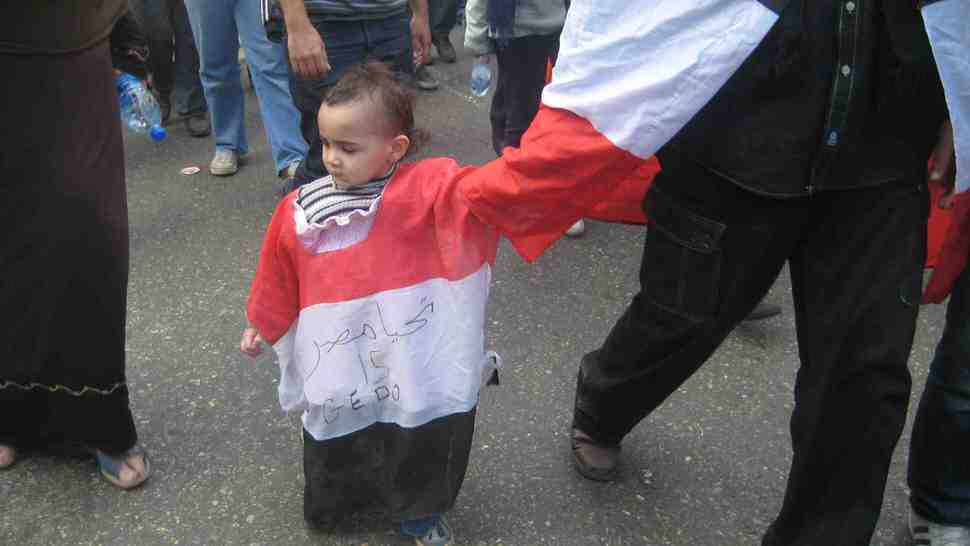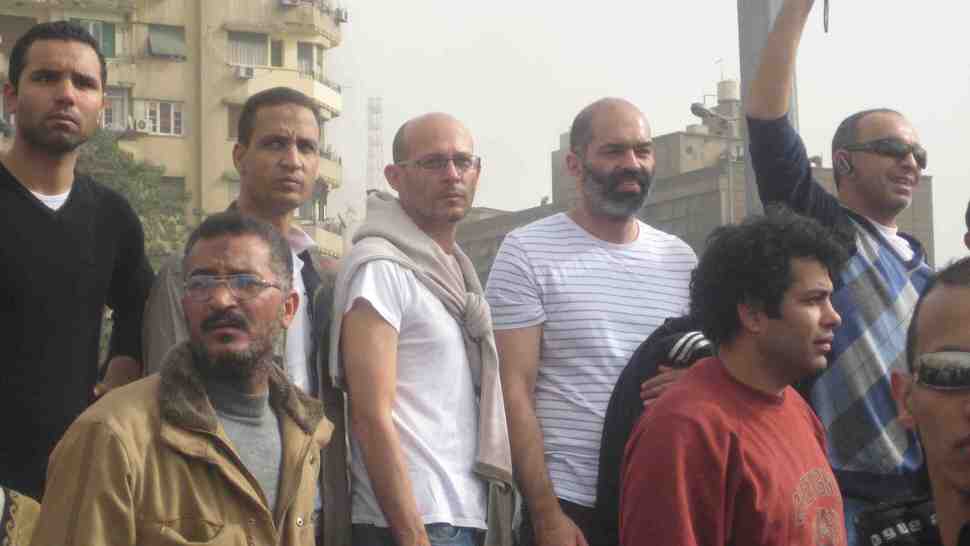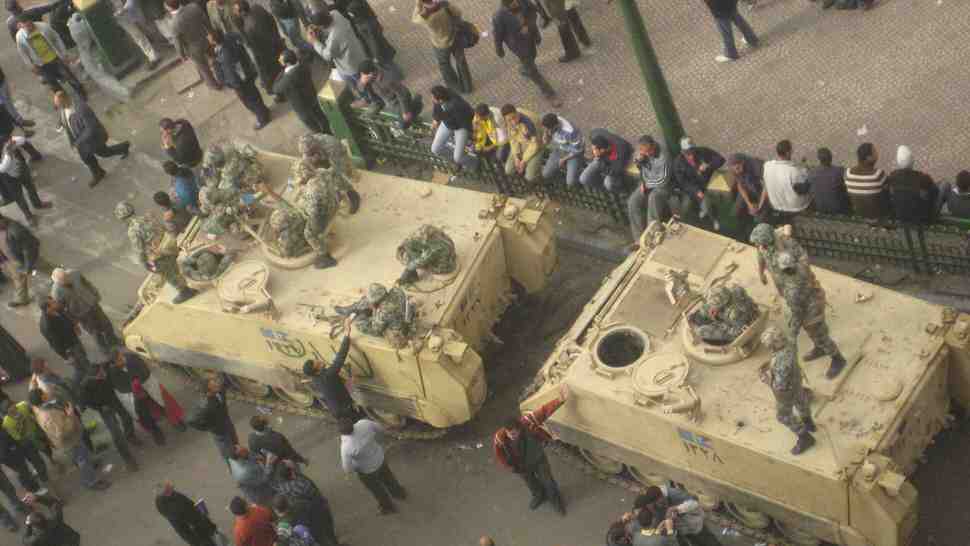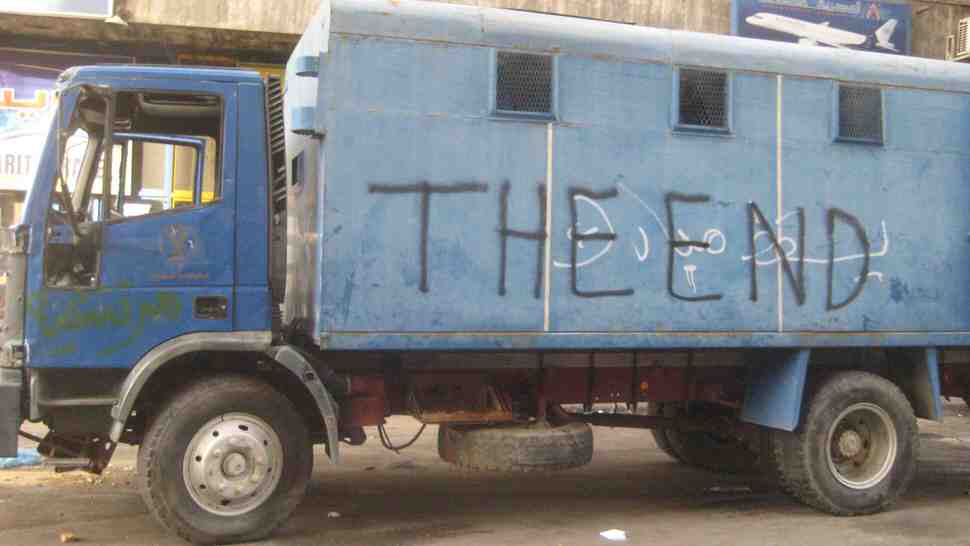On Thursday evening, January 27, activists in Cairo were on Twitter discussing the second wave of protests, which were supposed to begin after Friday’s midday prayer. Two days earlier, tens of thousands of people had taken to the streets and, despite a violent response by police and thugs, succeeded in occupying Tahrir Square; this time, it was hoped, many more would join in the peaceful revolt. A 26-page PDF “manual to the Egyptian revolution” was circulating by email. “It contains a list of tools, clothes, marching routes and so on,” the email said. “Please spread using only email, home printers, and local photocopiers. Do not spread using Facebook or Twitter as they are heavily monitored by Egyptian intelligence.”
We had hardly enough time to get the word out before communications went dark. Facebook was the first to go—at around 10 PM on January 27. Twitter was shut down shortly afterward. And then, at 12:19 AM, the Internet was turned off. I called an activist friend. “The ****ers,” she said. “It’s a matter of time before the mobile networks go. If we can’t get in touch in the morning, 11 AM, Cilantro Café. From there, to Moustafa Mahmoud mosque.”
The phone networks came down shortly after 9 AM Friday morning. I had just called Abeer Allam, the Financial Times’s Riyadh Correspondent. “Please try me in a while,” I had urged. “If my phone is off, it means mobile networks are down. Spread the news.” My next call would have been to my father, who lives alone—I wanted to check on him, and to let him know that I would be out on the streets that day—but it was too late.
I headed to the café early, not sure what to expect when the protests began. The government had warned that there would be a severe crackdown on any activism. We weren’t sure what this meant, and half expected to wake up Friday morning to find a city under siege by the army. Instead, we found just heightened security. Police and plainclothes informants were out in force, and mosques around the city were surrounded by state security and riot police.
At the café, I found dozens of young men and women—all of them discussing what the government might do. I saw a journalist friend, Lina Wardani, who had been beaten and detained by state thugs during the January 25 protest. She was badly bruised. I also spotted Hala El Koussy, an artist who had also been at Tuesday’s protest. In the far corner, a plainclothes informant with three mobiles on his table was talking to the café manager, who at one point got up and checked the locks on the café’s glass entrance doors. “They may lock us in and then take us away,” Hala said, pointing to the three blue prisoner’s trucks parked on a side street. “We should get out of here now.”
It was 11:30 AM. We paid and left, breaking off into groups. I went with Hala and two of her friends—both women. A police agent followed us down the road, his ear to a mobile phone. We jumped in a cab, hoping to throw him off.
By the time we got to the Moustafa Mahmoud mosque around noon, it was packed. People were spilling into the streets, their prayer rugs rolled out on the pavement. In the women’s section, I spotted faces I had seen at the protests in the days before, many of them without prayer rugs, praying on the Egyptian flag instead. “Let us respect this sacred space,” the imam began his sermon through a loudspeaker, “and all turn off our phones.” The crowd—by then numbering in the thousands—erupted into laughter. He talked about this time of change the country was facing, and about Egyptian youth. “What we have found these days,” he said, “is that our youth really love their country.” There was a roar of applause. “They are asking for the democratic rights that every country should have. Free speech,” he continued, to more impassioned clapping.
As the sermon went on, we noticed plainclothes security agents moving into the crowd. My friend nodded towards them, alerting me. I was scared, thinking they might grab us the moment the prayer was over. As the imam said his last words, the crowds stood up, raised flags and banners, and pushed through the security and began to march into the street, chanting the Arabic name for Egypt: “Misr, Misr, Misr, Misr. The people of this country want the government to step down!”
Outside the mosque, there were already thousands of people marching. We joined them and formed small human chains, holding hands, pushing forward. People suddenly seemed more confident, encouraged by the numbers. We crossed the main street, Gamaat Al Dawal, and headed towards the bridge. There probably were about ten thousand protesters at this point, but it felt like there were many more.
Advertisement
On Tuesday, the protesters had been on edge; no one knew which way things would go and what the government would do. Now—despite the initial fears following the Internet and phone blackout Friday morning—everyone I asked described feelings of “exhilaration” and “euphoria.” Riot police were everywhere, but the crowd outnumbered them. The demographic of the protesters had shifted too: from Tuesday’s activist movement dominated by young upper middle-class Egyptians with Twitter accounts had broadened to include masses of middle-class and lower middle-class people, even children. It had become a popular movement.
People cheered on the marchers from their balconies. I began to see people who had been in school with me, friends of the family, people who worked at local shops and kiosks. I spotted our local mechanic, and a man who bags goods at the supermarket down my street. The riot police didn’t seem to be doing anything. Reports were coming in about mass protests in other Egyptian cities. I was beginning to feel safer.
Suddenly, my friend Hala said, “I’m beginning to smell something, I’m beginning to smell something.” In a second, we all felt it. There was tear gas everywhere. The police had evidently figured out our route and attacked from the front. Someone began to distribute green facemasks to cover our mouths and nostrils—the same kind that the government had given out during the outbreak of Swine Flu. A man threw a box of them out of his balcony and into the crowd.
We ran forward. Graffiti was all over bridges and building sides. “Mubarak step down,” it said. “Mubarak, you’re fired!” A man began to chant “Allahu Akbar.” The crowd immediately shouted at him to stop. (The government had feebly attempted to portray the protesters as Muslim Brothers and it was important not to give any credibility to such charges.)
We continued for several miles. Families with their children were wrapped in the Egyptian flag. I noticed some professors from the American University. El Moallem, a well-known publisher was among us. I struck up a conversation with Hamdeen Sabahi, the popular opposition party leader who many believe could pose a threat to Mubarak in free and fair elections. “I’ve been jailed 17 times, but this regime won’t scare me,” he said.
It was around 2pm, and we had just heard reports that Mohamed ElBaradei had been stopped with his own march from another mosque. Activists and other opposition leaders were ambivalent about ElBaradei; he had not immediately joined the protests and he had spent too much time abroad. “ElBaradei is a tourist,” Sabahi told me. “He has lost credibility on the Egyptian street.” Still, many I talked to believed ElBaradei’s support was important, given his international stature. The riot police had formed a barricade before us and were firing rounds of tear gas; the march stopped moving.
For an hour the crowd battled the riot police, trying to push forward, then running back to avoid the fumes. I moved toward the front of the crowd to get a sense of what was happening. More rounds of tear gas were fired and I began to choke, my eyes burning. Someone put a vinegar-soaked towel to my face. It took about 15 minutes for the burning to subside.
At close to 2:30 PM, the crowds managed to break through the barricade of the riot police and onto Al-Galaa Bridge by the Sheraton Hotel. Guests stood on their balconies and cheered. On the bridge, four olive-green trucks had been deserted by their officers—the police had given up, and now sat forlorn on sidewalks. Young men climbed onto the trucks and raised the Egyptian flag. “To Tahrir,” they shouted, urging the crowd to keep marching, over the bridge, and the next, and into Liberation Square.
Some of us made it to Tahrir, others didn’t. The police were becoming increasingly ruthless. On another bridge filled with protesters they were firing tear gas from armored trucks at almost point-blank range. There were shrieks as young men and women got hit. People were rushed out, carried on their friends’ shoulders, some covered in blood. People started to get dizzy. My throat was sore from inhaling the sulfur. Somone shouted into a loudspeaker that we should change our route—into the residential island of Zamalek, past the Tunisian embassy, and then back again to Tahrir. Near the front of our crowd was Karim El Shafei, the CEO of one of Egypt’s largest investment funds.
At close to 6pm, still marching, we got news of the curfew and were told the army had been sent in. There were reports of rubber bullets being used, and we could hear shots in the air. People were also saying that the government had let loose criminals and thugs onto the streets. We weren’t sure if this was true, but the atmosphere was becoming increasingly chaotic.
Advertisement
Two hours after the curfew, I made my way home. I immediately regretted it: I switched on Al-Jazeera and realized that people were continuing to defy the curfew and large crowds remained in Tahrir Square. Everyone was waiting for President Mubarak to speak. We had been told earlier that he would address the nation. Now, it was after 8 PM, and there were reports of lootings, violence, and buildings in flames; but he still hadn’t appeared. By the time the president finally addressed the nation just after midnight, promising to dismiss his cabinet but refusing to resign, the public was outraged. An activist friend called me on my landline. “He doesn’t get it. We want him out—a change of cabinet means nothing! Tomorrow, to Tahrir again.”
People stayed in the streets until 3 AM, dodging security forces, running from thugs, trying to put out trash fires that were being ignited. They also cheered the arrival of the army rolled into the city in tanks and then stood by, not harassing the protesters. Many people couldn’t get home and sought refuge in friends’ homes, in office buildings. Five people I know slept at an art gallery.
By Saturday morning, mobile networks were back up. I headed out early, to Tahrir Square. There wasn’t a police officer in sight, but there were already hundreds of people, many chanting, some to see what had happened overnight. It looked like a war zone. Broken glass and garbage littered the streets. Empty tear gas canisters were lying around. Charred remains of overturned police trucks and cars were strewn on the sidewalks. The headquarters of Mubarak’s ruling National Democratic Party, which had been set on fire Friday evening, was completely blackened and still burning. The Hardees restaurant that occupies one corner of the square, was on fire, its glass exterior in smithereens.
Army tanks were positioned around the square, blocking all roads leading into it, but allowing people on foot to enter. The crowd grew fast. By around 2pm there were ten thousand people. I found an archaeologist friend, Nora Shalaby, who was worried about the nearby Egyptian Museum. The building next to it was in flames, and there were rumors that it had been attacked by looters. Someone reassured her that protesters had encircled the building and vowed to guard it until the army arrived. Civilians were beginning to act in the place of police, who had completely disappeared from the streets. Young men—protesters—were directing traffic.
We circled the square and found Mohamed Waked, my friend who had been taken away during the January 25 protests. “They stuck me in a cell meant to hold twenty people,” he said. “There were about a hundred people in there with me. We were on top of one another.” Some were released within hours—“the ones with connections,” he said. Mohamed had been held for 36 hours before they released him. “They dropped us on a road in the desert in the middle of nowhere and told us to walk home.”
Saturday’s curfew had been set for 4 PM, but it was already 3 PM, and at least 40,000 people were in the area around Tahrir Square by then. No one was planning to go home. Young men started to distribute bananas and biscuits. They also organized the crowds and began to patrol the area for signs of disruption. The people and the army increasingly seemed to be united—civilians sat on army tanks chatting with the soldiers. People were now chanting “The people and the army want the system to change.”
We could hear shots apparently coming from the direction of the nearby Interior Ministry and tear gas was again drifting in. Someone said that three people had been killed, including a child. The crowd stopped its chanting and kneeled down in prayer. The curfew had long passed, and we wondered what would happen next.
Soon after we learned that the government had released criminals from several prisons and along with paid state security thugs they had run amok in the city, looting and vandalizing stores, infiltrating the city’s residential districts, breaking down doors and robbing people’s homes. I received phone calls from friends and family urging me to go home. “Terrible things are happening in your area,” a journalist friend said.
I stayed in the square a bit longer, taking in the cries of outrage when reports came in that Omar Suleiman, the president’s intelligence chief, had been appointed vice president. Suleiman, over 70, was one of the president’s men, and only Mubarak stepping down would satisfy the protesters.
I got home just after 8 PM. The streets in my neighborhood were dark and empty, except for dozens of young men, some with knives, others with baseball bats, rifles, batons. “The young men of the area are patrolling,” someone explained. “The thugs have already tried to get in here and the police have vanished.”
On my street, porters had taken the bulletproof vests and metal barricades left behind by the police when they fled. Balcony lights were turned on, as had been advised. I went around my house closing the heavy wooden shutters. A glass door facing the street worried me, and I taped it over with newspaper. Friends were calling in to report break-ins. Every one I spoke to felt the rumors were true: the government had decided to create chaos to get people off the streets and give it a pretext for a brutal crackdown. Reports had already come in that some of the thugs arrested by the army had state security IDs.
During the night, I could still hear gunfire, and the occasional helicopter above. I was scared, but also enraged. I talked to many friends on the phone, and everyone agreed that America had to do something—“It is in Hillary and Barack’s hands” one said.
On Sunday morning, the streets were eerily quiet. The army was downtown, but no sign of police or any plainclothes thugs. I headed out, in search of a fax machine or an Internet connection. Some of the few people I did see said that the government must be planning some new response. Around 3 PM, reports of arrests came in. Journalists, in particular, were being targeted. Carrying a notebook, I was stopped and questioned, but managed to allay any suspicions and went on my way. Not long after, I could hear fighter jets flying low over the city.
Protesters were heading back to Tahrir Square. There are reports that the new vice president has met with the interior minister to discuss the security situation. So far at least one hundred people have been killed, and over a thousand injured. Local television is filled with images of street violence and criminals on the loose. Though Sunday is a business day here, many supermarkets and businesses are closed and all ATMs seem to be depleted. Banks will be closed again on Monday, we are being told, and the stock market has dropped 23 percent. The government is expected to announce a new cabinet, but the protesters—who by 5 PM, long after the curfew, again numbered in the tens of thousands—are waiting for Mubarak to step down. They say they will not leave until he goes. “There is no going back now.”


